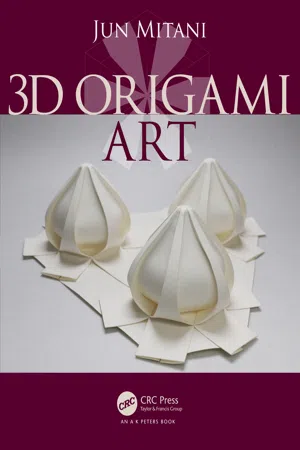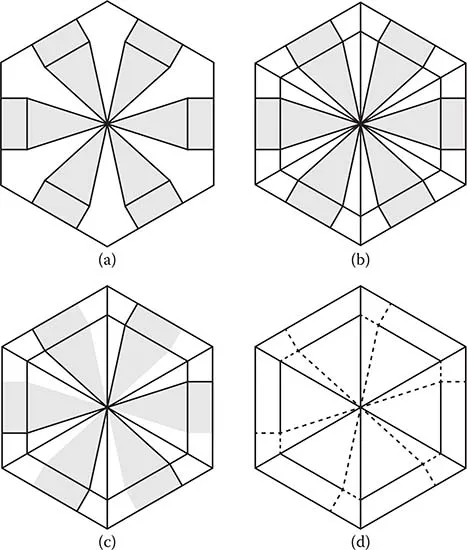1 Axisymmetric 3D Origami
This chapter introduces you to the design techniques for axisymmetric three- dimensional (3D) origami shapes such as those in Figure 1.1. Some look as if wrapping a solid and others partly sticking to a solid, both with external projections. The following explains four types combined with two solid wrapping types and two external projection types.
1.1 Four Basic Types
The polyhedron on the left in Figure 1.2 is formed by rotating the polygonal line on the right (called the section line) around the vertical dash-dot axis at 60-degree intervals and connecting the vertices. In computational geometry (CG) and computer-aided design (CAD), this polyhedron is generated with a method called rotational sweep (the base is intentionally excluded in Figure 1.2). This chapter targets origami shapes having a structure that appears as if it wraps an axisymmetric polyhedron like in Figure 1.1 with one sheet.
There are various ways of wrapping a solid. We are looking at two methods in Figure 1.3: (a) overlaying ("cone type") and (b) cylindrical, surrounding from outside ("cylinder type"). Each type corresponds to the candy wrapping method in the Prologue, Figure P.13. The solid does not have to be completely wrapped and can have its top and
bottom left open. Use a regular polygonal sheet for the cone type and a rectangular sheet for the cylinder type.
The solid can have two types of external projections: a thin pleat called a flat pleat, and a thick solid pleat (triangular cross section) called a 3D pleat (Figure 1.4).
1.2 Basic Crease Patterns
As content common to the four different types of 3D origami, let's look at a rotationally swept solid and its crease pattern. In Figure 1.5, the solid on the left can be made by putting six of the parts on the right together.
For the cone type, the crease pattern components are placed on radially on a plane around the center as in Figure 1.6. The sheet used will be a regular polygon. Pleats are made from the margins outside the parts.
For the cylinder type, the crease pattern components are aligned at equal intervals as in Figure 1.7. The sheet used will be a rectangle. Pleats are made from the margins outside the parts.
Pleats are formed by adding new fold lines in the margins on the pattern. The way of adding fold lines varies depending on whether the pleat shape is flat or a triangular cross-sectional solid.
The following sections explain the four 3D origami types varying with the combination of pleat and wrapping types.
Figure 1.1 Axisymmetric 3D origami shapes presented in this chapter, from the left, flat-pleat cone type, flat-pleat cylinder type, 3D-pleat cone type, and 3D-pleat cylinder type.
Figure 1.2 Rotationally swept axisymmetric solid (left) and polygonal line (right) used for making the solid.
Figure 1.3 Two ways of wrapping a solid: cone type (a) and cylinder type (b).
Figure 1.4 Two pleat types: flat pleat (left) and 3D pleat (right).
Figure 1.5 Rotationally swept solid and its components.
Figure 1.6 Components placed radially.
Figure 1.7 Components placed horizontally at equal intervals.
1.3 Flat-Pleat Cone Type
Shapes of this type have external flat pleats and look as if they are covering a solid from the top (Figure 1.8).
The crease pattern for this type can be created as follows. First, place the crease pattern components at equal intervals radially with their tips at the center as in Figure 1.9a. Second, add fold lines in the margins as in Figure 1.9b, so as to connect each vertex of the outer regular polygon to its center and to extend each part's horizontal line segment. Third, as in Figure 1.9c, erase the polygonal contour lines from each component (left-side polygonal lines are erased in the example). Last, assign mountains and valleys as in Figure 1.9d. A mountain fold line (solid) makes a convex when viewed from outside and a valley fold line (dashed) a concave.
Figure 1.8 Flat-pleat cone-type solid shape.
Through the above sequence, the flat-pleat cone-type crease pattern can be created for various axisymmetric solids.
Figure 1.9 Flat-pleat cone-type crease pattern structure.
1.4 Flat-Pleat Cylinder Type
Shapes of this type have external flat pleats and look a...









